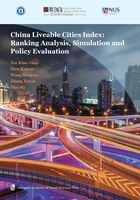
Foreword
In China, the concept “liveable cities” is always in the limelight, drawing attention from politics, academia, and the general public. A variety of discussions and rankings about liveable cities exist, but a consensus is never reached. President Xi Jinping, in his visit to Shanghai during The Second China International Import Expo, said, “The city belongs and caters to its people. Shanghai must lead a new way of megacity governance with Chinese characteristics, and we must continue to improve the capability and capacity of the government for managing such a socialist modern international metropolis.” It can be said that the study on liveable cities index, jointly conducted by the Institute of Economics of the Shanghai Academy of Social Sciences (SASS) and Asian Competitiveness Institute (ACI), is with the same spirit of incentivising“a city to be built for its people”. This joint study, in the context of contemporary urban research and development practices, is thus of great significance. More specifically, there are three points to highlight.
Firstly, this project yields timely and ground-breaking results. The research team designed a systematic and scientific index framework of five environments: Economic Vibrancy & Competitiveness, Environmental Friendliness & Sustainability, Domestic Security & Stability, Socio-Cultural Conditions, and City Governance. With this framework did the team thoroughly investigate the conceptual components of liveability. It is also commendable that the research team collected more than 30,000 survey samples from residents in 100 Chinese cities and integrated perceptions of ordinary residents into the evaluation. I believe that evaluating the liveability of a city from the perspective of its ordinary residents is the most intuitive approach; any study on liveability without an account of public sentiments would be incomplete, non-objective and inconclusive.
Secondly, this project provides constructive and heuristic advice. The research team believed that a pure ranking is like a beauty contest that lacks actionable insights,so it decided to use What-if simulation analysis to tackle the “so what” question. This effort completes the study by identifying paths for cities to catch up or even surpass other competitors in the same region. As shown by the analysis, most cities will leap forward in the ranking significantly if overcoming their shortfalls, while 16 of them may even take over Yantai to rank at the first place.
Thirdly, the results of this project provide strongly practical reference and guidance for policymakers. Both overall and environment-wise rankings for the 100 Chinese cities are available as results. For example, Shanghai ranks 9thoverall, 2ndin Domestic Security & Stability, 5thin Economic Vibrancy & Competitiveness, 15thin Socio-Cultural Conditions, 33rdin City Governance, and 86thin Environmental Friendliness &Sustainability. The highs and lows in rankings clearly evidence Shanghai's pros and cons. Shanghai has ambitious missions; the city sees itself become, by 2035, a global city, a city of innovation, a city of humanities, a sustainable city, and an influential socialist modern international metropolis. As liveability is fundamental to these targets, the liveability rankings deserve the credit for allowing local governments to identify gaps and priorities.
That being said,I believe that the 2019 ACI—SASS China Liveable Cities Index is a meaningful study worthy of attention.It is a serious attempt to comprehensively explore the components of liveability and the formulation of related policies. I also believe that with the joint contribution by governments and all walks of life, Chinese cities will become more attractive, and their residents will live in peace and work in contentment.
Professor Yu Xinhui
Secretary of Party Committee
Shanghai Academy of Social Sciences